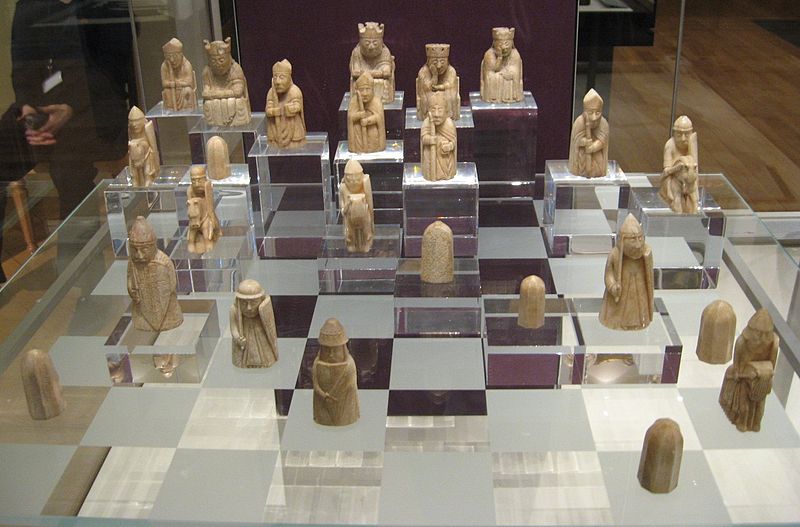A Warder from the Isle of Lewis
The year was 1964, when an antique dealer in Edinburgh purchased a small figurine made of ivory, for 5 pounds. When he died, it was passed on to his daughter, who placed it in a drawer, carefully wrapped in a cloth. From time to time she took the beautiful figure out of its repository and enjoyed the sight of it. Last year the family, who remain anonymous, brought the piece to Sotheby's for an expert evaluation. The expert there, Alexander Kader, could not believe what he was holding in his hands.
"I said, 'Oh my goodness, it's one of the Lewis Chessmen'."
Although the antique dealer had catalogued the figure only as an "Antique Walrus Tusk Warrior Chessman", it had not been associated with the Lewis Chessmen before. Sotheby's estimated the proceeds ahead of the auction at 600,000 to 1 million pounds. [Update: It ultimately went for GBP £735,000.]
 The "Mega" is the database every serious chessplayer needs. The database contains 7.6 million games from 1500 to 2018, in highest quality standard, full of top level analyses and completely classified.
The "Mega" is the database every serious chessplayer needs. The database contains 7.6 million games from 1500 to 2018, in highest quality standard, full of top level analyses and completely classified.Long-lost Lewis Chessman found in Edinburgh family's drawer | Video: BBC
Over the past few weeks, Sotheby's has explored the history of the piece — a Warder (rook) soldier figure, to find out how and why it was separated from the rest of the pieces. Their conclusions are spelled out in great details on the item's auction page, but are briefly summarized:
The...visual comparison between the present warder and the Lewis chessmen discovered in 1831 and on display in UK public collections demonstrates that the present warder is of the Lewis chessmen type and supports the opinion that it was made in the same workshop.
The presence of erosion in the form of a network of narrow channels on the surface of the present warder, which is a characteristic shared with the chessmen from the Lewis hoard, indicates that it was buried in sandy soils for a long period of time. This aspect is significant since it corroborates the likelihood that it was once buried in the same environment as the Lewis hoard. The rarity of the present warder and by extension the absence of extant ivories of Lewis chessmen type, further supports this view.
Interestingly, radiocarbon dating analysis indicates that the newly discovered piece likely hails from between 1328 and 1434, which would put it about 80 years later than the generally accepted date estimated for the larger Lewis hoard. However there is not yet any comparative radiocarbon dating for any of the pieces currently housed in museums, and so further analysis is needed, especially to account for the effect of the pieces having been buried for 800 years.
 The Scotch Gambit is a brazen yet utterly sound system for White who immediately opens up the position, by sacrificing a central pawn, in an attempt to assassinate the enemy king as quickly as possible.
The Scotch Gambit is a brazen yet utterly sound system for White who immediately opens up the position, by sacrificing a central pawn, in an attempt to assassinate the enemy king as quickly as possible.The Lewis Chessmen were first shown on April 11th, 1831 at an antiques exhibit in Edinburgh. The exact circumstances of the find are unknown. They are said to have been found in a brick chamber in the Uig Bay on the island of Lewis (see map), an island of the Outer Hebrides. The find included 93 objects, including 59 chess pieces, 19 additional pawns and 14 non-chess pieces (plus a belt buckle), mostly carved from walrus ivory. A knight and four rooks were missing. Sotheby's suggests the new piece is one of those:
...if it is correct that the Lewis chessmen comprised four chess sets then four Warders are missing. It is a logical deduction that the present warder could be one of the lost pieces from the Lewis group. However, it should be recognised that in the absence of a recorded find site for the Lewis hoard and for the present warder, there is and will continue to be healthy scholarly debate on this subject.
It is believed that the figures were made in the 12th or 13th century in Norway near Trondheim. How they came to the island of Lewis is unknown. The BBC ran an in depth look at the Lewis chess pieces in a 2010 feature story in the series "A History of the World in 100 Objects" (transcript available).
Description: Lewis Chessmen Status Symbols (1200 - 1400 AD) — Neil MacGregor examines a board game, found in the Outer Hebrides but made in Norway, which takes us to the world of Northern Europe at a time when Norway ruled parts of Scotland
By far the most likely explanation for their being there, is that they were hidden for safety by a merchant, who may have been intending to sell them on Lewis itself. A thirteenth-century poem, for example, names a powerful figure, Angus Mor of Islay, as King of Lewis, and has him inheriting his father's set of ivory chess pieces:
"To you he left his position, yours his breastplate ... each treasure ... his slender swords, his brown ivory chessmen."
After the first exhibition, the find was split: 82 pieces are now in the British Museum in London while 11 pieces are held at the National Museum of Scotland in Edinburgh.

The Lewis Chessmen at the British Museum | Photo: Public Domain via Wikimedia Commons
Translation from German and additional reporting: Macauley Peterson
Links
.jpeg)























